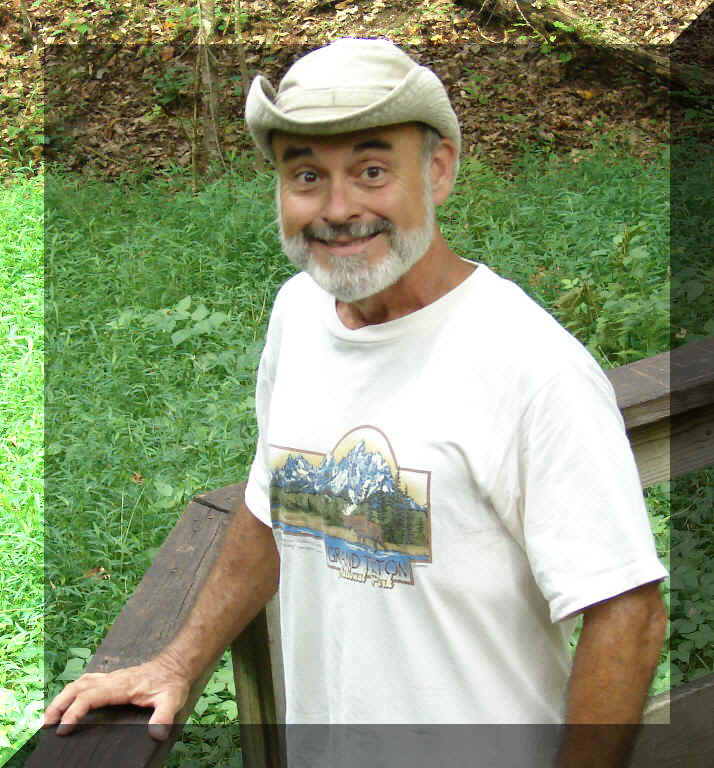


Welcome to the Bibb County, Alabama pages of
Jim
Allison, botanist
All photographs on these pages taken by James R. Allison in Bibb County, Alabama
(except as noted) and © 2011. All rights reserved.
Photographs are reduced in dimensions and compressed for the
benefit of visitors with slow Internet connections. To
hear the background music [midi] files, you may need to enable ActiveX
controls.
Hi! I'm a botanist (a
biologist specializing in plant life) living
in Georgia. But these particular pages are about the plant life of a single county in the middle of
the
neighboring state of Alabama.
The first
time I set foot in Bibb County,
Alabama was
in
August of 1989.
I went there on behalf of the U.S. Fish and Wildlife Service (USFWS) to
look for a rare native
perennial, Nevius'
stonecrop (Sedum
nevii).
This plant of shallow
soil accumulations on rocky 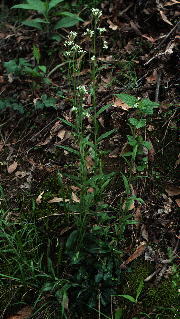 bluffs along major streams in Alabama,
Georgia, and
Tennessee was at the time an official candidate to receive legal
protection under the
national Endangered Species Act (ESA). To assess whether a species
should be
listed under the ESA, it is important to find out how the
species is faring and to determine what threats might jeopardize its
continued
existence.
bluffs along major streams in Alabama,
Georgia, and
Tennessee was at the time an official candidate to receive legal
protection under the
national Endangered Species Act (ESA). To assess whether a species
should be
listed under the ESA, it is important to find out how the
species is faring and to determine what threats might jeopardize its
continued
existence.
By hiking
from roads it proved fairly easy
to find
this Sedum
at the few places in Bibb County from which it had been reported
previously.
Upon visiting one of these localesóLimestone
Park, on
the Little Cahaba RiveróI
found that it
was the site
of an outfitter for canoe trips on the Cahaba River. It occurred to me
that
canoe travel would be an ideal way to search for new populations of a
plant that
is usually found along streams. Not quite two months later, I returned
to Bibb County with a
friend who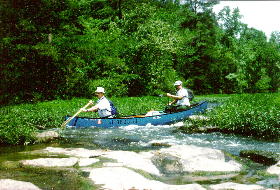 shared my longtime interest in plants of rock outcrops and
who was an
aficionado of
cacti and succulents (such as Sedum
nevii). In two days of
canoeing we found Sedum nevii
at
several new locations along the Little Cahaba River, Six Mile Creek,
and the
Cahaba River. Indeed, it is probably only the number of Bibb
County populations
of
Nevius' stonecrop that has kept it off the Endangered Species
List.
shared my longtime interest in plants of rock outcrops and
who was an
aficionado of
cacti and succulents (such as Sedum
nevii). In two days of
canoeing we found Sedum nevii
at
several new locations along the Little Cahaba River, Six Mile Creek,
and the
Cahaba River. Indeed, it is probably only the number of Bibb
County populations
of
Nevius' stonecrop that has kept it off the Endangered Species
List.
In 1992 I received a contract from
the USFWS to assess the status in Alabama
of another candidate for listing under the ESA, Georgia
rockcress (Arabis
georgiana). Once again, this was
a plant
already known
from Bibb County, from the vicinity of a couple of bridge crossings of
the
Cahaba River. Thinking that another canoe trip might turn up more
populations of
Georgia rockcress, as it had a few years earlier for Nevius'
stonecrop,
I invited three friends (Tim
Stevens, of Montgomery, and Jim and Debi Rodgers, now of Senoia,
Georgia) to
join me for some canoeing on the Cahaba and Little Cahaba
Rivers.
We
chose Memorial
Day weekend, since 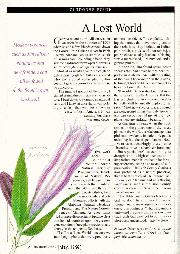 even if the rockcress
proved
elusive, we would be assured the memorable experience of passing
through several
river stretches filled bank-to-bank with spectacular flowering
colonies of Cahaba
lilies (Hymenocallis
coronaria, image at right, below).
This
plant of river
shoals has inspired an annual Cahaba Lily Festival in the
Bibb County
town of West
Blocton.
even if the rockcress
proved
elusive, we would be assured the memorable experience of passing
through several
river stretches filled bank-to-bank with spectacular flowering
colonies of Cahaba
lilies (Hymenocallis
coronaria, image at right, below).
This
plant of river
shoals has inspired an annual Cahaba Lily Festival in the
Bibb County
town of West
Blocton.
As it turned out, we found several new populations of Georgia
rockcress, plus some odd and unfamiliar plants. A couple of the plants
collected
that weekend turned out to
be new to Alabama, and some others resisted all attempts to identify
them, at least
as known species. Over the course of repeated return visits, many of
them with
Tim Stevens (in the front of the canoe in the image at right, above, taken by
Jim
Rogers), it became clear
that Bibb County contained an amazing
assemblage of rare plants. Chief among these were eight
plants
that had never been
named and described, and seven that had never been found before in Alabama,
including a
wildflower that had not been seen anywhere
in more than a
century-and-a half. We also found a lichen that had never been recorded from
closer than Arkansas (but lichens are not plants). Click on the thumbnail at left to read a short write-up by Jennifer
Greer that
appeared in Southern Living
in 1999.
I formally
described and named the
new plants
in 2001, in Castanea, the
peer-reviewed journal of the Southern
Appalachian Botanical Society.
The SABS awarded the article the
2002 Richard
and Minnie Windler Award for the systematics paper judged the best of
the
preceding year published in Castanea.
My website
includes an online
edition of the Castanea
article, with a good many color
images
that could
not be included in the original for reasons of cost and space.
The original is available in PDF form by clicking here
(34 megs, so a broadband connection is advised).
Since then the area with the greatest concentration of rare plants has been acquired by the Nature Conservancy of Alabama, assuring its protection for the benefit and enjoyment of generations yet unborn.
This phenomenal area, the Kathy Stiles Freeland Bibb County Glades Preserve, has been the subject of several magazine articles. Among the more recent ones was by Bill Garland, in the April 2008 issue of Outdoor Alabama, in which the discovery of the Bibb County Glades was called the botanical discovery of the [twentieth] century! Well, I can hardly claim objectivity with regard to such a claim, and I suppose the same can be said for many an Alabamian. If you need convincing (or if you don't), check out this lavishly photo-illustrated story by clicking on the image of the magazine cover below at left (which, a bit ironically, shows a flower head of Georgia aster).
One year later the Bibb County Glades were the subject of an article titled "The Magic Rock Garden," in the April 2009 issue of Natural History by Robert J. Mohlenbrock. To read it (without the illustrations) click here or click on the image of the cover, below right, to see my [low-quality] scan of it.
Another
celebration of this magical place is
traveling our roads and highways every day in many places
simultaneously! At the 2006 Cahaba Lily Festival, U-Haul International, Inc.
premiered the Alabama
edition of its rental vans
celebrating America's wonders, "Venture
Across America." The graphic that was placed on over 600 of the company's large
vans is shown below, at center.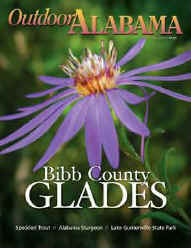
Here are links to my other Bibb County Glade pages. The first is a non-technical discussion of rare plants of Bibb County, especially the discoveries that began with the fateful canoe expedition of Memorial Day weekend, 1992. The original version first appeared several years ago in a botanical newsletter called Panga:
The second link is to a special web version, with many additional color images, of the scientific paper in which the Bibb County ecosystem richest in rare plants was first discussed in detail, and in which I formally described the new plants:
The third link is to some material supplementary to that paper:
Page last updated: January 20, 2011